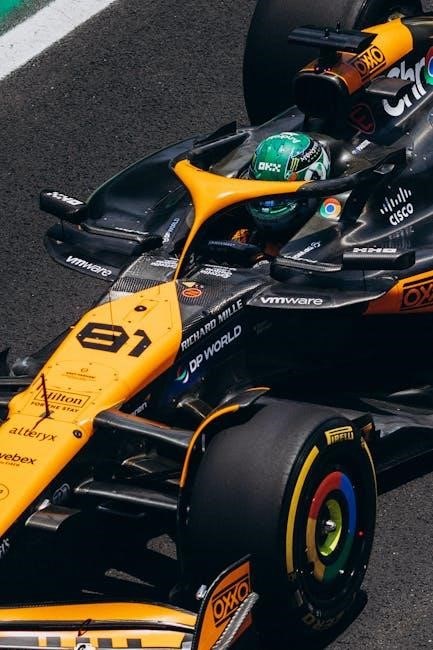Race car vehicle dynamics is the study of forces and motions affecting a vehicle’s performance. It combines engineering principles‚ aerodynamics‚ and tire behavior to optimize speed and stability.
1.1 Historical Overview of Vehicle Dynamics in Racing
The study of vehicle dynamics in racing has evolved significantly over the decades‚ with early developments focusing on understanding the fundamental physics of motion. Pioneers like William F. Milliken laid the groundwork with comprehensive analyses of tire behavior‚ suspension systems‚ and aerodynamics. Their work‚ documented in texts like Race Car Vehicle Dynamics‚ provided the foundation for modern race car engineering. Historical advancements in simulation tools and data acquisition have further refined these principles‚ enabling precise tuning for optimal performance.
1.2 Importance of Vehicle Dynamics in Race Car Performance
Vehicle dynamics play a critical role in race car performance‚ directly influencing speed‚ stability‚ and handling. By optimizing factors like weight distribution‚ suspension‚ and aerodynamics‚ teams can enhance cornering capabilities‚ reduce braking distances‚ and improve overall lap times. Understanding these principles allows engineers to fine-tune cars for specific tracks‚ ensuring maximum efficiency and competitiveness. Proper vehicle dynamics ensure consistent tire behavior‚ better energy absorption‚ and improved driver control‚ making it a cornerstone of race car engineering.

Key Concepts in Race Car Vehicle Dynamics
Key concepts include weight distribution‚ center of gravity‚ and aerodynamic principles‚ all of which enhance performance‚ stability‚ and control‚ ensuring optimal race car handling and speed.
2.1 Fundamental Physics of Vehicle Motion
Fundamental physics principles such as forces‚ motion‚ and energy govern race car dynamics. Friction‚ inertia‚ and gravity influence acceleration‚ braking‚ and cornering. Newton’s laws explain how forces affect motion‚ while energy balance determines speed and handling. Understanding these concepts is crucial for optimizing vehicle performance and stability on the track.
2.2 Engineering Principles Applied to Race Cars
Engineering principles like lightweight materials‚ aerodynamics‚ and mechanical systems optimize race car performance. Materials science ensures strength-to-weight ratios‚ while aerodynamics enhances downforce and reduces drag. Suspension and chassis design prioritize handling and stability. Propulsion systems‚ including engines and gearboxes‚ are engineered for power and efficiency. Data acquisition and simulation tools enable precise tuning‚ ensuring optimal performance on the track.
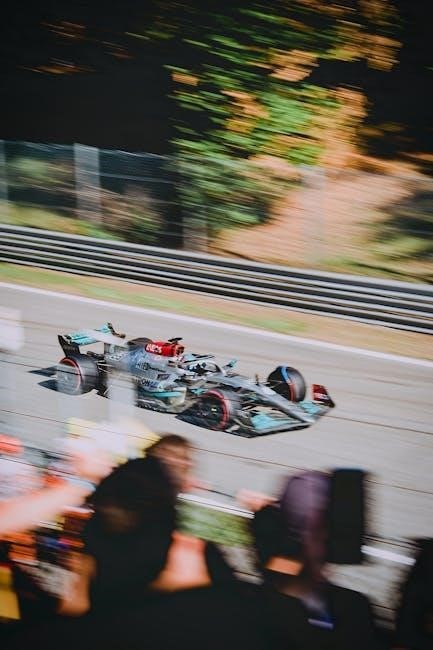
Aerodynamics in Race Car Design
Aerodynamics plays a crucial role in race car design by enhancing speed and stability. Wings‚ diffusers‚ and body shapes generate downforce‚ reducing drag and improving cornering grip.
3.1 Role of Aerodynamics in Race Car Performance
Aerodynamics is critical for race car performance‚ as it enhances speed‚ stability‚ and fuel efficiency. By generating downforce‚ aerodynamic elements like wings and diffusers improve cornering grip and reduce drag‚ allowing cars to maintain higher speeds. This optimization ensures better control and reduces braking distances‚ directly impacting lap times and overall competitiveness. Advanced aerodynamic designs are tailored to balance performance with efficiency‚ making them indispensable in modern racing.
3.2 Design Elements for Optimal Aerodynamic Efficiency
Key design elements for optimal aerodynamic efficiency include the front splitter‚ undertray‚ side pods‚ and rear wing. These components work together to minimize drag and maximize downforce. The front splitter directs airflow under the car‚ while the undertray and diffuser enhance ground effect for increased grip. Side pods house radiators while smoothing airflow. Lightweight materials and computational fluid dynamics further refine these designs‚ ensuring peak performance without compromising speed or stability. Wind tunnel testing validates these optimizations.
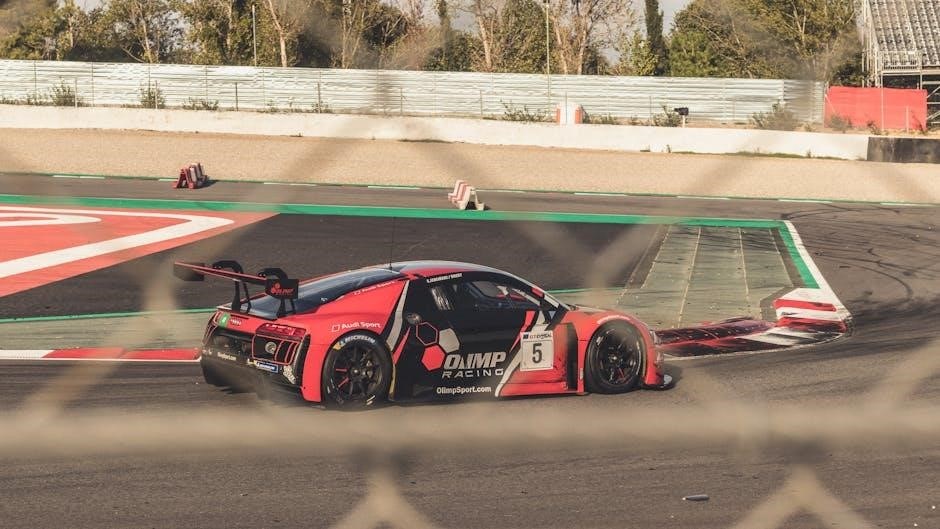
Suspension Systems in Race Cars
Suspension systems are critical for handling‚ stability‚ and performance. They absorb impacts‚ maintain tire contact‚ and optimize weight transfer. Customizable dampers and springs ensure precise control and responsiveness.
4.1 Suspension Geometry and Its Impact on Handling
Suspension geometry plays a crucial role in determining a race car’s handling characteristics. Key parameters like camber‚ caster‚ and toe angles significantly influence tire contact‚ stability‚ and cornering performance. Adjusting these geometries optimizes weight transfer‚ traction‚ and responsiveness‚ ensuring precise control during high-speed maneuvers. Proper alignment enhances aerodynamic efficiency and reduces wear‚ while incorrect settings can lead to instability and reduced grip. Fine-tuning suspension geometry is essential for maximizing performance on various racing circuits and conditions.
4.2 Types of Suspension Systems Used in Racing
Race cars utilize various suspension systems to optimize performance. The double wishbone setup is common for its precise handling and aerodynamic efficiency‚ often used in open-wheel racing. Multi-link suspensions offer superior stability and control‚ favored in high-downforce applications. Pushrod and pullrod systems are popular in series like Formula 1 and IndyCar for their adjustability and compact design. Each system is chosen based on specific racing needs‚ balancing adjustability‚ weight‚ and aerodynamic efficiency.
4.3 Tuning Suspension for Different Racing Conditions
Suspension tuning is critical for optimizing race car performance across varying conditions. Adjustments to spring rates‚ damping‚ and anti-roll bars tailor handling for specific tracks. On smooth circuits‚ stiffer setups enhance stability‚ while softer configurations improve grip on bumpy surfaces. Aerodynamic loads and tire behavior also influence suspension settings. Teams use data from testing to fine-tune geometries‚ ensuring balance and responsiveness. Proper tuning enhances stability‚ reduces wear‚ and maximizes tire performance‚ crucial for competitive racing.
Tire Dynamics and Behavior
Tire dynamics and behavior are crucial for race car performance‚ influencing traction‚ wear‚ and handling. Factors like temperature‚ pressure‚ and track conditions significantly impact grip and stability.
5.1 Understanding Tire Characteristics and Grip
Understanding tire characteristics and grip is essential for optimizing race car performance. Tires are the only contact point with the track‚ making their behavior critical. Key factors include tire compound‚ temperature‚ and pressure‚ which influence traction and wear. The tire’s ability to maintain grip under varying loads and speeds determines cornering ability and braking efficiency. Proper tire management ensures consistent performance‚ while misuse can lead to reduced grip and increased lap times. Tire dynamics directly impact handling and stability.
5.2 The Relationship Between Tires and Vehicle Dynamics
Tires play a critical role in race car vehicle dynamics‚ as they directly influence handling‚ stability‚ and performance. Their behavior affects weight transfer‚ traction‚ and responsiveness. Tire characteristics like stiffness‚ slip angles‚ and wear patterns impact how forces are distributed. Proper tire setup ensures optimal grip and balance‚ while mismatches can compromise stability. Tire dynamics are integral to achieving predictable and consistent vehicle behavior‚ making them a cornerstone of race car performance optimization and driver control.
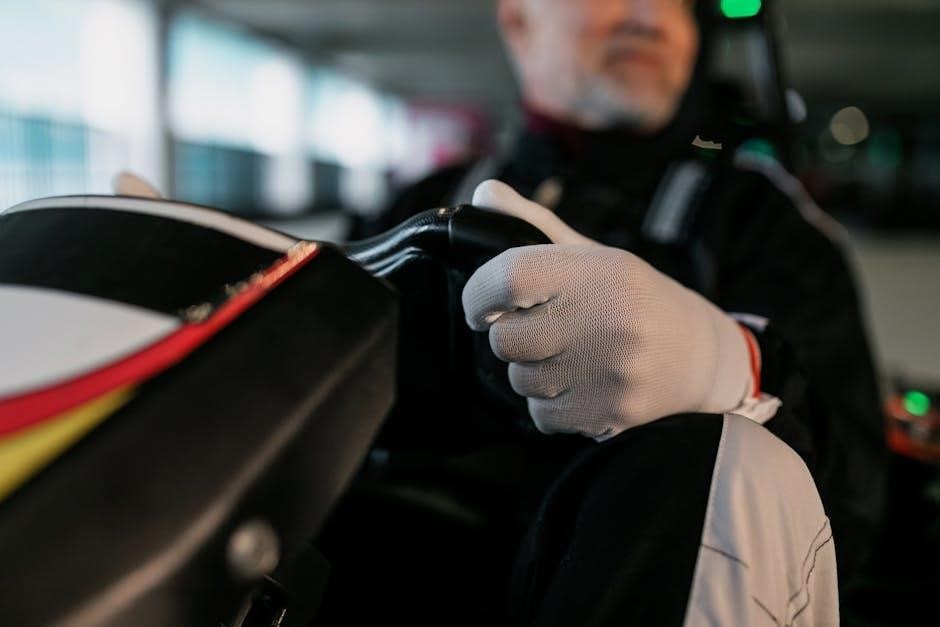
Transmission and Drivetrain
The transmission and drivetrain are crucial for race car performance‚ governing power delivery and traction. They influence acceleration‚ cornering‚ and overall vehicle stability‚ directly impacting lap times and handling precision.
6.1 The Role of Transmission in Race Car Dynamics
The transmission plays a pivotal role in race car dynamics by managing power delivery from the engine to the wheels. It ensures optimal gear ratios for acceleration and speed‚ minimizing power loss during shifts. Seamless transmission operation enhances traction‚ stability‚ and cornering capabilities. Proper transmission setup directly impacts lap times‚ making it a critical component for competitive racing performance and overall vehicle handling efficiency on the track.
6.2 Optimizing Drivetrain for Maximum Performance
Optimizing the drivetrain is critical for maximizing race car performance. This involves refining gear ratios‚ differential setups‚ and drivetrain components to enhance power delivery and efficiency. Lightweight materials‚ such as carbon fiber‚ reduce rotational mass‚ improving acceleration. Advanced lubricants and coatings minimize friction‚ while precise alignment ensures optimal energy transfer. These adjustments collectively enhance speed‚ stability‚ and control‚ directly contributing to faster lap times and competitive edge in racing environments.
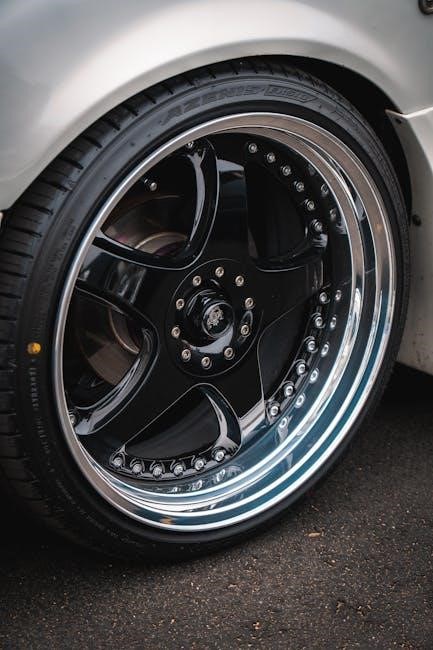
Brake Systems and Their Dynamics
Brake systems are essential for controlling race car speed and stability. They involve precise engineering of components like discs‚ calipers‚ and pads to optimize friction‚ heat management‚ and dynamic handling.
7.1 Brake Dynamics and Their Impact on Vehicle Stability
Brake dynamics significantly influence race car stability by managing deceleration and weight transfer. Effective braking systems ensure consistent grip‚ preventing wheel lock-up and maintaining tire adhesion. Advanced materials and cooling technologies enhance thermal stability‚ while precise brake balance optimizes handling under varying conditions. Proper brake dynamics enable drivers to maintain control during high-speed maneuvers‚ directly impacting lap times and safety.
7.2 Advanced Brake Technologies in Racing
Advanced brake technologies in racing include carbon-carbon brake systems‚ offering exceptional heat resistance and consistent performance. Brake-by-wire systems enable precise control‚ while regenerative braking captures energy for hybrid powertrains. These innovations enhance stopping power‚ reduce wear‚ and improve safety. They also allow for better thermal management and faster response times‚ critical for competitive racing environments where milliseconds can determine outcomes.
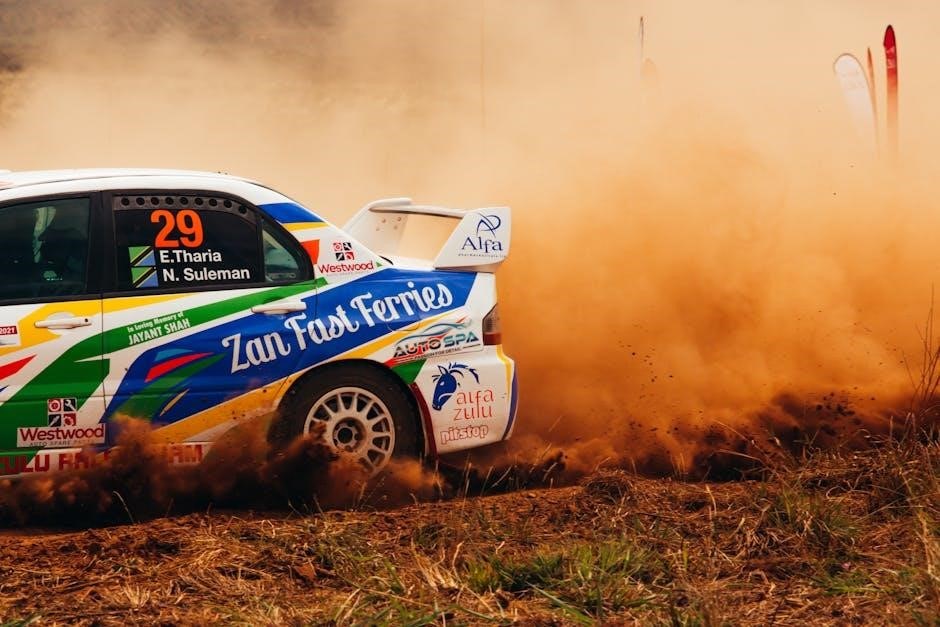
Weight Distribution and Balance
Weight distribution significantly impacts race car handling‚ stability‚ and performance. Optimal balance enhances traction‚ reduces tire wear‚ and improves cornering capabilities‚ ensuring better control and speed.
8.1 The Importance of Weight Distribution in Racing
Weight distribution is critical in race car performance‚ directly influencing handling‚ stability‚ and responsiveness. A balanced setup ensures optimal tire contact‚ improving traction and reducing wear. Proper distribution enhances cornering capabilities and overall control‚ minimizing understeer or oversteer. Teams meticulously adjust weight to suit specific tracks‚ ensuring maximum performance and safety. This balance is key to achieving competitive speeds and maintaining consistency across varying race conditions.
8.2 Achieving Optimal Balance for Stability and Speed
Achieving optimal balance in race cars involves precise adjustments to weight distribution‚ aerodynamics‚ and suspension geometry. This balance ensures stability at high speeds while maintaining responsiveness. Teams use data acquisition systems to monitor performance and fine-tune setups. Adjustments may include modifying suspension stiffness‚ aerodynamic angles‚ or weight distribution to enhance cornering grip and straight-line speed. Proper balance minimizes understeer or oversteer‚ maximizing overall performance and driver control‚ ensuring both safety and competitiveness.

Electronic Systems and Their Role
Electronic systems enhance race car performance by optimizing engine control‚ traction‚ and data monitoring. They improve efficiency‚ safety‚ and driver feedback‚ enabling real-time adjustments for competitive advantage.
9.1 Electronic Stability Control and Traction Systems
Electronic Stability Control (ESC) and traction systems are critical in race cars‚ enhancing stability and grip. ESC uses sensors to detect loss of traction‚ automatically adjusting engine power or braking individual wheels to stabilize the vehicle. Traction control optimizes wheel slip during acceleration‚ improving stability and reducing understeer or oversteer. These systems enhance cornering speeds and driver confidence‚ while advanced algorithms adapt to track conditions‚ ensuring optimal performance without compromising safety or handling precision.
9.2 The Use of Sensors and Data Acquisition in Racing
Sensors and data acquisition systems are integral to modern race car dynamics; They collect real-time data on parameters like speed‚ acceleration‚ and tire telemetry. This information is analyzed to optimize performance‚ fine-tune setups‚ and improve lap times. Advanced sensors monitor engine performance‚ brake temperatures‚ and suspension loads‚ enabling precise adjustments. Data acquisition also aids in driver feedback‚ helping teams make strategic decisions and enhance overall vehicle dynamics for competitive advantage.
Simulation Tools for Vehicle Dynamics
Sensors and data acquisition systems are integral to modern race car dynamics. They collect real-time data on parameters like speed‚ acceleration‚ and tire telemetry. This information is analyzed to optimize performance‚ fine-tune setups‚ and improve lap times. Advanced sensors monitor engine performance‚ brake temperatures‚ and suspension loads‚ enabling precise adjustments. Data acquisition also aids in driver feedback‚ helping teams make strategic decisions and enhance overall vehicle dynamics for competitive advantage.
10.1 The Use of Computer Simulations in Race Car Development
Computer simulations play a pivotal role in race car development by enabling engineers to test and optimize designs virtually. These simulations analyze aerodynamics‚ weight distribution‚ and suspension dynamics‚ reducing reliance on physical prototypes. Tools like computational fluid dynamics (CFD) and finite element analysis (FEA) allow precise modeling of race car behavior under various conditions. This approach accelerates development‚ reduces costs‚ and enhances performance by identifying optimal configurations before real-world testing begins.
10.2 Popular Software for Vehicle Dynamics Analysis
Popular software tools like MATLAB‚ Simulink‚ and Adams are widely used for vehicle dynamics analysis. These programs enable engineers to simulate complex systems‚ including suspension‚ aerodynamics‚ and tire behavior. Other notable tools include Abaqus for finite element analysis (FEA) and ANSYS for structural and thermal simulations. These software solutions provide precise modeling‚ allowing race teams to optimize performance and reliability before physical testing‚ ensuring competitive edge in racing environments.
Case Studies and Real-World Applications
Real-world examples from Formula 1 and NASCAR demonstrate how optimized vehicle dynamics enhance performance. Case studies reveal how teams achieve faster lap times through aerodynamic and suspension tuning.
11.1 Successful Implementations of Vehicle Dynamics in Racing
Real-world applications in Formula 1 and NASCAR highlight how advanced vehicle dynamics improve performance. Teams like Mercedes-AMG F1 and Hendrick Motorsports use precision-engineered suspensions‚ aerodynamic optimizations‚ and tire management strategies to dominate races. These implementations demonstrate how vehicle dynamics directly translate to faster lap times‚ better handling‚ and increased stability‚ proving their critical role in competitive racing environments.
11.2 Lessons Learned from Professional Racing Teams
Professional racing teams have shared valuable insights into optimizing vehicle dynamics. Continuous testing‚ data-driven decisions‚ and rapid adjustments are crucial for a competitive edge. Emphasizing teamwork‚ adaptability‚ and attention to detail ensures peak performance. These lessons highlight the importance of innovation and practical application‚ directly influencing race car design and strategy for future success.
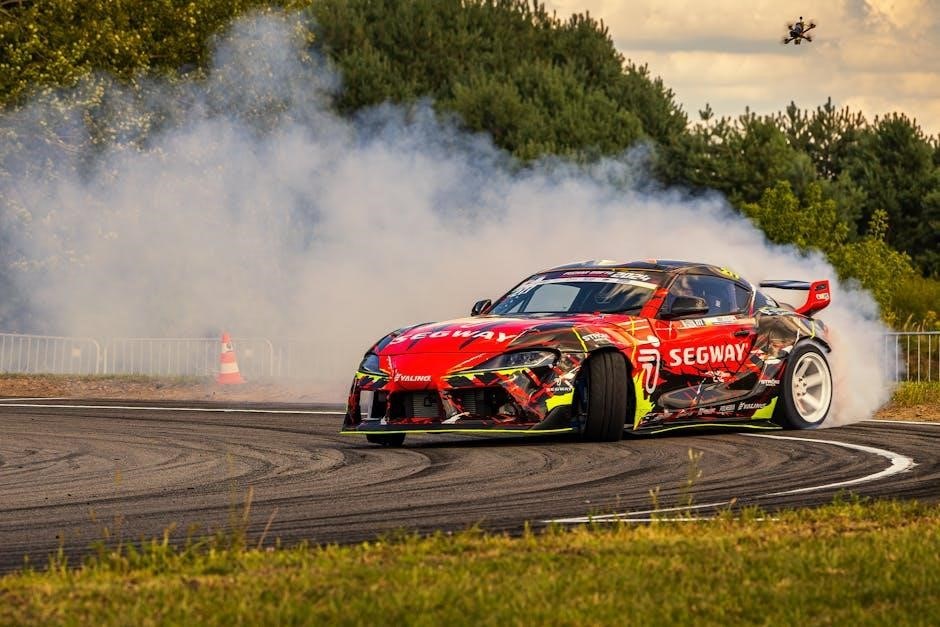
Future Trends in Race Car Vehicle Dynamics
The future of race car vehicle dynamics focuses on hybrid powertrains‚ advanced lightweight materials‚ and AI-driven systems‚ optimizing performance while reducing environmental impact.
12.1 Emerging Technologies and Their Impact on Racing
Emerging technologies like hybrid powertrains‚ advanced composites‚ and AI-driven systems are revolutionizing race car dynamics. Hybrid systems combine electric and combustion engines for efficiency‚ while lightweight materials enhance speed. AI optimizes performance‚ predicts failures‚ and improves safety. These innovations are reshaping aerodynamics‚ suspension‚ and tire dynamics‚ enabling faster‚ greener‚ and safer racing. Regulatory shifts toward sustainability further accelerate adoption‚ ensuring a high-tech‚ eco-friendly future for motorsports.
12.2 The Role of Sustainability in Future Vehicle Dynamics
Sustainability is reshaping race car dynamics‚ driving innovations like electric powertrains‚ biofuels‚ and lightweight materials. Regenerative braking and energy-efficient systems reduce environmental impact while enhancing performance. Advanced aerodynamics and sustainable manufacturing practices further minimize ecological footprints. As regulations prioritize eco-friendly technologies‚ racing becomes a testbed for green solutions‚ ensuring a balance between speed‚ efficiency‚ and environmental responsibility for future generations.
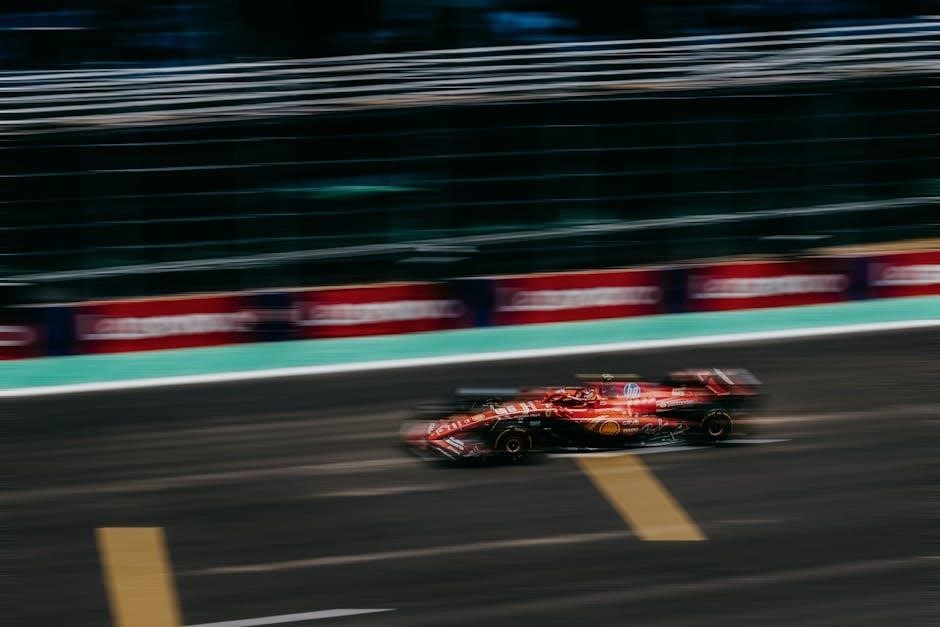
Resources for Further Study
Explore textbooks‚ online courses‚ and software tools for deeper understanding of race car dynamics‚ offering practical insights and advanced analysis techniques for enthusiasts and professionals alike.
13.1 Recommended Textbooks on Vehicle Dynamics
Key textbooks include “Tire and Vehicle Dynamics” by Hans B. Pacejka‚ “Race Car Vehicle Dynamics” by William F. Milliken‚ and “Engineering and the Science of Racing Cars” by Tony Purnell. These resources provide in-depth analysis of vehicle dynamics‚ combining theoretical principles with practical applications. They are essential for enthusiasts and professionals seeking to enhance their understanding of race car performance‚ offering detailed insights into physics‚ engineering‚ and real-world racing scenarios.
13.2 Online Courses and Tutorials for Race Car Enthusiasts
13.3 Useful Software and Tools for Vehicle Dynamics Analysis
Software like MATLAB‚ Simulink‚ and ADAMS are essential for analyzing race car dynamics. MATLAB and Simulink enable simulation and modeling of vehicle systems‚ while ADAMS specializes in multi-body dynamics. ANSYS is used for structural and aerodynamic analysis‚ and AVL VSM supports powertrain modeling. OptiStruct optimizes structural components for weight and strength. These tools help engineers refine designs‚ improve performance‚ and ensure safety in race car engineering.
Race car vehicle dynamics is crucial for optimizing performance‚ stability‚ and safety. Understanding these principles ensures competitive edge and innovation in motorsport engineering and design.
14.1 Summary of Key Concepts
Race car vehicle dynamics integrates aerodynamics‚ suspension‚ tires‚ and drivetrain to maximize performance. Key concepts include weight distribution‚ downforce generation‚ and tire grip optimization. Engineering principles like balance‚ stability‚ and precision engineering are critical. Advanced technologies‚ such as electronic stability control and data acquisition‚ enhance competitiveness. Understanding these elements ensures optimal vehicle behavior‚ enabling faster laps and better control. This holistic approach is essential for achieving peak race car performance and reliability in competitive environments.
14.2 The Evolution and Future of Race Car Vehicle Dynamics
Race car vehicle dynamics has evolved significantly‚ driven by advancements in technology and materials. Historically‚ innovations like aerodynamic designs and lightweight composites transformed performance. Looking ahead‚ electric powertrains‚ autonomous systems‚ and sustainable materials will shape the future. Data-driven approaches and advanced simulations will optimize designs. The integration of AI and real-time analytics promises even greater efficiency and speed. Sustainability remains a key focus‚ ensuring race cars continue to thrill while embracing eco-friendly technologies.
